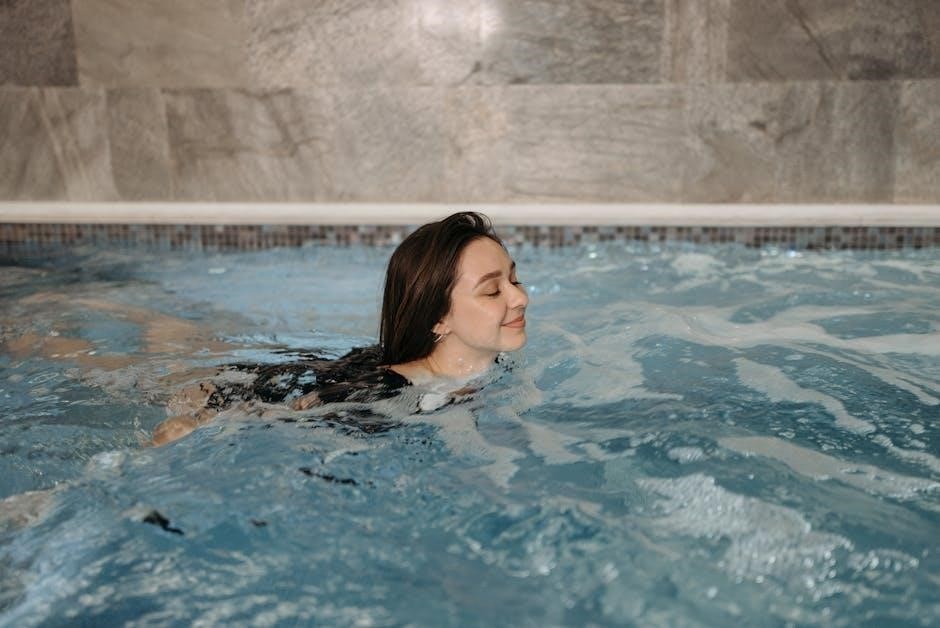Aquatic therapy, also known as hydrotherapy or water therapy, involves exercises performed in a pool or aquatic environment. This therapeutic approach is often used to rehabilitate injuries, manage chronic conditions, and improve overall fitness, with personalized exercise plans.
Overview of Aquatic Therapy
Definition and Background
Aquatic therapy, also referred to as hydrotherapy, is a specialized form of exercise performed in a pool or aquatic environment. It leverages water’s unique properties, such as buoyancy, resistance, and hydrostatic pressure, to facilitate rehabilitation and improve physical function. Historically, water has been used for therapeutic purposes across various cultures, with modern aquatic therapy evolving into a structured and evidence-based intervention. The warmth of the water promotes muscle relaxation, while buoyancy reduces joint stress, making aquatic exercise ideal for individuals with musculoskeletal conditions or those recovering from injuries.
Aquatic therapy offers numerous advantages, including reduced joint stress due to buoyancy. It also enhances strength, endurance, flexibility, and range of motion, while improving circulation and decreasing swelling, making it a versatile therapeutic option.
Reduced Joint Stress
One of the primary benefits of aquatic therapy is the significant reduction of joint stress. The buoyancy of water counteracts the effects of gravity, effectively decreasing the weight-bearing load on joints. This is particularly advantageous for individuals with arthritis, those recovering from injuries, or those who are overweight. Aquatic exercises allow for a greater range of motion and reduced pain, facilitating easier and more comfortable movement compared to land-based exercises. This makes it a gentler approach to rehabilitation and fitness.
Improved Strength and Endurance
Aquatic therapy effectively enhances both strength and endurance. The water provides resistance in all directions, requiring muscles to work harder to perform movements. This constant resistance helps to build muscular strength and improve overall endurance without placing excessive stress on the joints. Regular aquatic exercises can lead to increased cardiovascular fitness. The hydrostatic pressure of the water also aids in improving circulation, contributing to enhanced endurance levels. This makes aquatic therapy a valuable tool for athletes and individuals seeking to improve their physical performance.
Increased Range of Motion and Flexibility
Aquatic therapy is highly effective in increasing range of motion and flexibility. The buoyancy of water reduces the effects of gravity, making it easier to move joints through a greater range. The warmth of the water helps to relax muscles and reduce stiffness, further enhancing flexibility. Aquatic exercises often involve gentle stretching and movements that can improve joint mobility and reduce muscle tension. This makes aquatic therapy beneficial for individuals with arthritis, back pain, or other conditions that limit movement.

Benefits of Aquatic Therapy
Decreased Swelling and Improved Blood Flow
Immersion in water during aquatic therapy sessions helps reduce swelling and improve blood flow. The hydrostatic pressure of water creates a gentle compression effect, which aids in reducing edema and inflammation in the extremities. This pressure also supports venous return, facilitating better circulation throughout the body. The increased blood flow delivers more oxygen and nutrients to tissues, promoting healing and reducing pain. These benefits make aquatic therapy a valuable intervention for individuals recovering from injuries or managing conditions like lymphedema.
Core Elements of an Aquatic Program
A successful aquatic program relies on various service providers. These include physical therapists, occupational therapists, and trained aides. Each professional plays a crucial role in designing, implementing, and monitoring the aquatic therapy exercises to ensure patient safety.
Aquatic Service Providers and Roles
Aquatic therapy programs involve a multidisciplinary team to ensure effective and safe treatment. Physical therapists design and supervise exercises, addressing specific impairments. Occupational therapists focus on functional activities, adapting tasks to the aquatic environment. Certified aquatic therapists assist with patient handling and exercise instruction. Rehabilitation therapists with specialized training in aquatic interventions play a crucial role. These professionals collaborate to tailor programs to individual needs, maximizing the benefits of aquatic exercises and rehabilitation. Their expertise ensures proper technique, progression, and safety throughout the therapy process.
Therapeutic Properties of Water
Water offers unique therapeutic benefits for exercise and rehabilitation. Buoyancy reduces weight-bearing stress on joints, allowing for easier movement and reduced pain. Hydrostatic pressure decreases swelling and improves circulation. Viscosity provides resistance for muscle strengthening, while turbulence challenges balance and coordination. Water’s thermal properties promote muscle relaxation and pain relief. These properties combine to create an ideal environment for performing a variety of aquatic exercises, enhancing rehabilitation outcomes and overall well-being. The warmth of the water also helps to soothe muscles.
Physiological Responses to Water Immersion
Immersion in water triggers several physiological changes that can be beneficial during aquatic therapy. Hydrostatic pressure increases venous return and cardiac output, improving cardiovascular function. Renal blood flow is also enhanced, promoting diuresis and reducing edema. Water immersion can also reduce blood pressure due to the redistribution of blood volume. The sensory input from water stimulates the nervous system, potentially decreasing pain perception. Respiratory function can be affected, with increased work of breathing due to chest wall compression. These responses contribute to the therapeutic effects of aquatic exercises.
Aquatic exercises employ water’s buoyancy and resistance. This provides a safe, effective environment for rehabilitation and fitness. Methods range from simple movements to complex routines, enhancing strength, flexibility, and cardiovascular health.
Warm-up Exercises
Warm-up exercises in aquatic therapy prepare the body for more intense activity by gradually increasing heart rate and blood flow to the muscles. These typically involve low-impact movements that enhance joint lubrication and flexibility. Examples include arm circles, leg swings, and torso twists performed in chest-deep water. Walking forward and backward, as well as side-stepping, are also effective. These activities help prevent injury by improving muscle elasticity and reducing stiffness, ensuring a safer and more comfortable therapeutic exercise session in the water.
Stretching Exercises
Stretching exercises in aquatic therapy aim to improve flexibility and range of motion, utilizing the water’s buoyancy to support the body and reduce joint stress. Common stretches include hamstring stretches, calf stretches, and shoulder stretches, all performed while standing in the water. Holding onto the side of the pool for balance can enhance stability. The warmth of the water further aids muscle relaxation, allowing for deeper and more effective stretches, promoting increased flexibility and decreased muscle tension during the therapeutic session.
Aquatic Exercises and Methods
Strengthening Exercises
Strengthening exercises in aquatic therapy use the water’s resistance to build muscle strength and endurance. These exercises can include leg lifts, arm raises, and core strengthening movements, performed against the water’s natural resistance. The buoyancy of the water reduces the impact on joints, making it ideal for individuals with arthritis or recovering from injuries. The consistent resistance of the water challenges muscles throughout the entire range of motion, promoting balanced muscle development and increased functional strength.
Specific aquatic exercises target particular muscle groups and movement patterns, leveraging water’s properties. Exercises such as partial squats, heel raises, and leg lifts can improve strength, flexibility, and balance while minimizing joint stress, promoting healing and fitness.
Partial Squats
Partial squats in aquatic therapy are performed in chest-level water, holding the pool’s side for balance. With feet shoulder-width apart, squat down until the water reaches neck level, then return to the starting position. This exercise strengthens leg muscles with reduced joint stress due to buoyancy. Repeat the exercise multiple times per set. Ensure proper form and controlled movements for optimal benefit and safety during the activity. Water adds resistance, enhancing muscle engagement.
Heel Raises
Heel raises are a beneficial aquatic exercise performed in chest-high water to strengthen calf muscles and improve ankle stability. Stand with feet flat on the pool floor, then slowly raise up onto your toes, lifting your heels as high as comfortable. Hold briefly, then lower back down with control. Use the pool wall for balance if needed. The water’s resistance adds intensity, while buoyancy reduces joint stress, aiding in rehabilitation and fitness.
Knee Lifts
Knee lifts are an aquatic exercise designed to improve hip and knee flexibility, core strength, and balance. While standing in chest-deep water, slowly lift one knee towards your chest, maintaining an upright posture. Hold briefly, then lower the leg back down with control, alternating legs. Engaging core muscles helps stabilize the body, enhancing the exercise’s benefits. The water’s buoyancy supports movement, reducing impact on joints. This exercise promotes functional mobility and is useful in rehabilitation.
Specific Aquatic Exercises
Leg Lifts
Leg lifts in aquatic therapy target hip flexors, quadriceps, and abdominal muscles, enhancing leg strength and core stability. Standing in chest-deep water, extend one leg straight forward, keeping the knee straight. Slowly lift the leg as high as comfortable, then lower it back down with control. Avoid leaning back or arching the back to maintain proper form. Repeat on both legs, focusing on controlled movements. Leg lifts improve lower body strength.

Indications and Contraindications for Aquatic Therapy
Aquatic therapy is indicated for various conditions, including arthritis, back pain, fibromyalgia, multiple sclerosis, and post-operative rehabilitation. Water’s buoyancy reduces joint stress, making it ideal for those with limited mobility or pain. However, certain contraindications exist. Individuals with uncontrolled infections, severe cardiac or respiratory conditions, open wounds, or bowel/bladder incontinence should avoid aquatic therapy. A thorough medical evaluation is essential to determine suitability, ensuring safety and maximizing the benefits of aquatic exercises.
Aquatic Therapy for Specific Conditions
Aquatic therapy provides gentle support and resistance, easing pain and improving function for individuals with chronic low back pain. Specific exercises can strengthen core muscles, increase flexibility, and reduce stress on the spine.
Chronic Low Back Pain
Aquatic therapy offers a unique environment for managing chronic low back pain (CLBP) by utilizing water’s buoyancy to reduce joint stress. The warmth of the water promotes muscle relaxation, easing stiffness and pain; Therapeutic exercises performed in water can improve spinal stability, core strength, and flexibility, all crucial for CLBP management. These exercises often include gentle stretching, range-of-motion activities, and strengthening exercises, tailored to individual needs and limitations. Additionally, the hydrostatic pressure of the water can decrease swelling and improve blood flow, further aiding in pain reduction and healing.
Multiple Sclerosis
Aquatic therapy provides a supportive environment for individuals with Multiple Sclerosis (MS) to improve their physical function and quality of life. The buoyancy of water reduces the effects of gravity, allowing for easier movement and reduced joint stress during exercises. Water’s resistance can be used to strengthen weakened muscles and improve endurance. Common aquatic exercises for MS include walking, stretching, and range-of-motion activities. The warmth of the water can also help to relax muscles, reduce spasticity, and alleviate pain. The aquatic environment also offers a safe space to improve balance and coordination.
Fibromyalgia
Aquatic therapy can be highly beneficial for individuals with fibromyalgia, a condition characterized by widespread musculoskeletal pain and fatigue. The warm water helps to relax muscles, reduce pain, and improve circulation. The buoyancy of water reduces stress on joints, allowing for gentle exercises that improve range of motion and flexibility. Aquatic exercises such as walking, stretching, and gentle aerobics can help to improve cardiovascular fitness and reduce fatigue. The therapeutic effects of water can also help to improve mood and reduce stress levels, contributing to overall well-being for individuals with fibromyalgia.

Safety Considerations in Aquatic Therapy
Aquatic therapy offers numerous benefits, safety must be a primary concern. Before starting, individuals should be screened for any contraindications, such as infections or uncontrolled medical conditions. The water depth and temperature should be carefully monitored to prevent overheating or hypothermia. Qualified professionals should supervise sessions to ensure proper technique and provide assistance; Entry and exit from the pool should be safe and accessible, with appropriate handrails and non-slip surfaces. Participants should stay hydrated and be aware of their limitations, avoiding overexertion. Regular equipment checks and pool maintenance are crucial for a safe environment.
Aquatic Therapy vs. Hydrotherapy
While often used interchangeably, aquatic therapy and hydrotherapy have distinct focuses. Aquatic therapy, also termed as therapeutic aquatic exercise, primarily involves structured exercises in a pool, guided by a trained therapist. These exercises aim to rehabilitate injuries, improve function, and enhance fitness. Hydrotherapy, however, encompasses a broader range of water-based treatments, including the use of jets, whirlpools, and varying water temperatures. Hydrotherapy focuses on pain relief, muscle relaxation, and improving circulation. Aquatic therapy emphasizes active movement, whereas hydrotherapy often involves passive immersion and water manipulation.

Resources for Aquatic Exercise Programs (PDFs)
Numerous resources offer aquatic exercise programs in PDF format, providing accessible guides for various needs. Websites of physical therapy clinics, hospitals, and organizations like the Aquatic Exercise Association often provide downloadable PDFs outlining aquatic exercise routines. These programs may include warm-up routines, stretching exercises, strengthening exercises, and cool-down procedures, tailored for different fitness levels and conditions. Some PDFs focus on specific conditions like back pain or arthritis, while others offer general aquatic exercise routines. Always consult with a healthcare professional before starting any new exercise program, especially if you have underlying health conditions.
Aquatic therapy offers a versatile and effective approach to rehabilitation and fitness, leveraging the unique properties of water to reduce joint stress and enhance movement. The availability of aquatic exercise programs in PDF format makes these benefits accessible to a wider audience, providing structured guidance for various needs and fitness levels. However, it’s crucial to remember that individual needs vary, and consulting with a healthcare professional or qualified therapist is essential before beginning any aquatic exercise program. With proper guidance and adherence to safety precautions, aquatic therapy can be a valuable tool.
